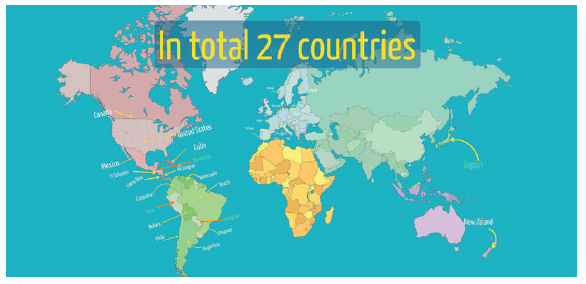Activities promoting fruit and vegetables consumption in eight AIAM5’s country members
What we did?
AIAM5 – Global Alliance for the Promotion of Fruit and Vegetable Consumption “5 a day” – brings together 28 national organizations from 27 countries that, under the motto “more fruits and vegetables, the best option for your health”, collaborate so global and national health promotion policies, include the daily fruit and vegetables consumption as a priority for the prevention and control of nutrition related diseases. Given that promotion of fruit and vegetable (F&V) consumption is the main goal of AIAM5 partners, it was proposed to collect their promotional activities to identify good practices in strategies, programs and activities to promote F&V consumption.

How did we do it?
A questionnaire for a systematically data collection was developed in order to categorize and identify strengths, weaknesses, opportunities, cost-effectiveness and feasibility, as well as the practices with the greatest potential adaptability to national health promotion policies in every country. Questionnaires from Mexico, Chile, Costa Rica, Venezuela, Colombia, Bolivia, Nicaragua and Spain, were assessed.
What results did we get?
Although the diversity of partners legal nature was highlighted, all of them did share the support of F&V professional sector, health, education and agriculture government departments and scientific societies, as well as consumer groups. Differences were observed between campaigns, as a consequence of the different national environments and partner profiles. The actions were framed in social marketing programs for health promotion and were classified into four major groups:
a. Communication, information and/or dissemination of the benefits of F&V consumption in different settings: fairs, sports events, markets, outlets, congresses, scientific and technical conferences, etc. The tools were diverse, although social networks and digital and traditional media, were predominant.
b. Research, scientific projects and positions, which helped entities and their partners to solve problems regarding messages understanding, allowed publication of scientific bulletins, consumption barriers identification surveys, good agricultural practices, etc.
c. Formal and informal education and/or training, through educational programs, lectures, workshops, etc., addressed to consumers, especially children and their families, either at school or community settings.
d. Corporate Social Responsibility (CSR) for companies’ competitive differentiation and improvement of their reputation, through preventing nutrition related diseases in their workforce or at community level.
What were the main conclusions?
In general, the activities carried out by the entities themselves, their partners and other collaborating entities that receive services during the campaigns were based on principles that have already shown a relevant impact on health promotion programs in the community scope. However, there were very few actions taken to evaluate changes in consumer awareness or attitudes toward changes in fruit and vegetable consumption, probably due to the limited financial and human resources, as well as to the limited and irregular supports by national governments.
What could be the keys to improve F&V promotional practices?
• Making every effort to run impact assessment measures by establishing performance indicators to evaluate the extent of the programs and their influence on F&V consumption patterns.
• Collecting systematically the added value achieved and/or perceived by the collaborating companies, those who use the campaign logo or receive services from the entity in the framework of CSR actions.
• Studying the payment of annual fees by the partners that form the “5 a day” type entities, to ensure the continuity of actions.
• Ratting the niche of opportunities offered by companies’ CSR to obtain resources and contribute to the dissemination and campaigns impact contributing to a healthier workforce, improving the food environments and the accessibility to fruit and vegetables at the community level.
• Adapting the visual materials already made by some AIAM5 partners as resources for social networks, promoting being active in these platforms because of their potential impact on the community.
• Keeping working to bring together the greatest possible support in the public and private sectors, civil society and entities such as “5 a day” organizations to facilitate coherence between national agricultural and health policies with the promotion of fruit and vegetable consumption.
Adapted from M.Moñino, E.Rodríguez, M.S.Tapia et al. “Evaluation of activities promoting fruits and vegetables consumption in 8 countries members
of the Global Alliance for Promoting Fruit and Vegetable Consumption “5 a day” – AIAM5. Rev Esp Nutr Hum Diet. 2016; 20(4): 281-297
